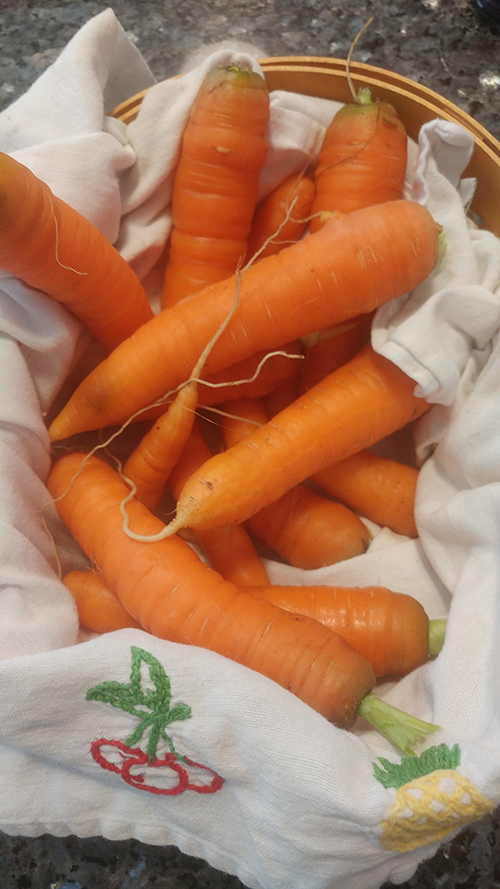by Linda Carloni
You have seeds from our Free Seed Library, the nursery, a catalog or a website. Now it’s time to plant seeds for your fall and winter garden. Birgitt Evans (article author and star of our seed planting video) and Kristen Smeal (videographer) cover planting seeds in containers really well.
Here is some information on how to plant some of those seeds right into the ground.
What to Plant
 This list will get you started in selecting what veggies are likely to grow well in your garden. This helpful information from the Alameda County Master Gardeners lists good cool season varieties and also indicates whether the plant seeds should be sown directly into soil where they will grow to maturity. Root crops – beets, carrots, and winter radishes (daikon or watermelon, among others) – do best sown directly. Large seeds like those for peas are also best directly sown. Other varieties can be sown directly or via seedlings.
This list will get you started in selecting what veggies are likely to grow well in your garden. This helpful information from the Alameda County Master Gardeners lists good cool season varieties and also indicates whether the plant seeds should be sown directly into soil where they will grow to maturity. Root crops – beets, carrots, and winter radishes (daikon or watermelon, among others) – do best sown directly. Large seeds like those for peas are also best directly sown. Other varieties can be sown directly or via seedlings.
Select the Place
Vegetables like sun, and in our heavily built environment, buildings create a good bit of shade. The sunny side of your yard may be very different in the summer than in the winter, so keep that in mind when deciding where to plant.
Prepare the Soil
First, take out any weeds or rocks where you’ll be planting seeds. Add a few inches of compost to your planting bed – it will improve the texture of your soil as well as adding nutrients. In Alameda’s sandy soil, you will probably also want to add some balanced fertilizer- especially if you have used the same patch before to grow veggies. Mix the compost and fertilizer into the top few inches of the soil. Carefully even the soil and water it. When you plant the seeds, you want the soil to be moist, but not wet, and definitely not soggy.
Planting the Seeds
Consult your seed packet – it will indicate how deep to plant the seeds, and how far apart the seeds should be planted. The general rule of thumb is to plant the seeds down 2 to 4 times the size of the seed, but the seed packet will have the best information. You may want to plant the seeds closer together than the seed packet recommends, because not all seeds germinate. If you do, you’ll need to thin them to the recommended spacing after they come up.
You can either make a small hole in the soil to the recommended planting depth (a chopstick is a great tool for this!) and then push the soil over to cover the seed, or you can cover the whole bed with fine soil so that the seed is covered to the right depth. Then mist the soil, taking care not to dislodge those lovely seeds or move the soil around.
Care after Planting
Make sure to keep the bed moist, and water it very gently to moisten it without disturbing it. Once the seeds have started to germinate, they’ll die if they dry out. Lightweight mulches like straw help keep moisture in. Carrots are particularly challenging to keep damp, because they have a long germination period – 14 to 21 days. I’ve found the unconventional practice of covering the carrot seed bed lightly with spare burlap works well. (Just be sure to check under the burlap a lot, as you’ll need to remove it soon after the plants are up.) Even after the little sprouts are up, keep the surrounding surface soil moist while the plants are tiny, as their roots will be very near the surface.
You’ll also need to keep the critters away. Squirrels may dig up the planting bed, and snails, slugs, birds and others enjoy the tiny succulent green sprouts. Consider covering your seed bed with floating row cover (easily located online) or a wire cage with a fine enough mesh to keep out snails, birds and the like. If you planted anything from the cabbage family directly into the ground, placing the floating row cover on before anything germinates will help lessen the dreaded cabbage looper infestation.
Fabric row covers also can help provide shade if the fall sun is too intense or the rains are heavy. Weed frequently to reduce competition but weed carefully to avoid damaging the seedlings.
Growing from seeds requires more advance thought than buying seedlings, but it’s not difficult, it’s less expensive, you have more choice of varieties, and there’s a thrill to eating what comes from the seeds you planted. Best of luck with your garden!
